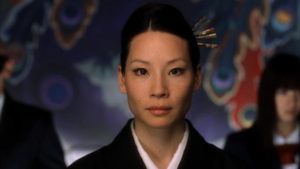“Revenge is a dish best served cold.” This sentence (straight out of 1982’s “Star Trek II: The Wrath of Khan” ) opens writer/director Quentin Tarantino’s Kill Bill: Volume 1, a film of great energy and versatility. Like a giddy schoolboy at recess, Tarantino crafts an admirable cinematic playground, complete with breathtaking action, cool characters, and colorful scenarios. Like Sergio Leone before him, Tarantino showcases an iconic warrior of cinema, destined to entertain fans for generations. Uma Thurman is his Clint Eastwood, and as a whole, the Kill Bill universe is a roaring rampage of frontier-like savagery. Together, Tarantino and Thurman take us on an outrageously brilliant ride that blends eastern and western sensibilities.

Of course, Kill Bill: Volume 1 falls into the revenge movie sub-genre. The story is very simple. After being beaten to a pulp and left for dead at her wedding rehearsal, the Bride (Uma Thurman) lies in a comatose state. Four years later, she awakens from her long slumber. Consumed by vengeance, she embarks on a journey that will pit her against former comrades. As she takes out these opponents, she gets closer and closer to her final target, Bill, the man who set this violent scenario into motion.
Best of all, Tarantino’s film is a celebration of female formidability and foreign inclusiveness. Thurman’s icy yet charming performance is a sight to behold. At times, her genuine charm permeates specific frames, ushering in further levels of empathy. Other times, her viscous individualism sets the groundwork for ensuing set pieces. When these scenes transpire, Thurman’s commitment to stunt work ups the visceral ante of each fight sequence, pushing the film into a state of exceptional practicality.

Clearly, everyone loves the Bride’s formidability. Watching her cut through corrupt opponents is extremely exciting. But overall, the Bride’s resolve stands out. Her most memorable moments come from the reaches of vulnerability. In other words, when she is pushed to the brink of death, she quickly adjusts, gaining the upper hand in the darkest of moments. That’s why she is empowering. She represents the importance of being completely in the moment, telling women everywhere that circumstances can be altered through the prism of intellectual resolve.
Next, we have Vernita Green, portrayed by Vivica A. Fox, a talented African American actress. At the onset of the film, we walk into a world that resembles blaxploitation cinema. Fox, with her swagger and forceful language, possesses Pam Grier-like sass, properly contributing to a well executed fight sequence and an intriguing conversation between foes. Lucy Liu, an Asian American actress, wonderful portrays the character of O-Ren Ishii, a leader amongst men. Like Thurman, Liu fits into an archetypal role often tailored for men, and she does a wonderful job. In a role that is extremely over the top, Liu plays it completely straight, giving us a memorable villain who always means business. During the climax, she battles Thurman to the death, in a setting that resembles Toshiya Fujita’s “Lady Snowblood” (1973).

There is Chiaki Kuriyama, who portrays O-Ren’s henchman, Gogo Yubari. Kuriyama chews up the scenery as a young, enigmatic warrior, and in the third act, her skills are on full display, whether it be interpersonal language or physical maneuvers. Lastly, we have Julie Dreyfus (a French actress). She plays Sofie Fatale, an intellectual woman filled with bilingual and lawyer expertise.
The supporting male roles are wonderfully presented. As Hattori Honzo, Sony Chiba, a Japanese legend, imbues the role with an abundance of wisdom, pain, and weariness. Gordon Liu, a Chinese legend, plays Johnny Mo, the leader of O-Ren’s personal army, the Crazy 88. Liu fits right into this environment, giving the flick an enlarged dose of style and physicality. I can only hope that these foreign performers will intrigue western viewers, pulling them into the hypnotic domain of eastern cinema.
Kill Bill: Volume 1 marks Tarantino’s foray into action moviemaking, and boy does he deliver. He understands that the buildup of an action scene is just as important as the physical conflict itself. Before a massive fight scene, we receive a long tracking shot, which gives us an uninterrupted view into the environment. This camerawork perfectly echoes the elongated visual fluidity of Brian De Palma, a master of suspenseful filmmaking. As the action gets closer and closer, Tarantino uses music and background noises to enhance the intensity of every conflict, like Sergio Leone used to in his spaghetti westerns.

Tarantino and Robert Richardson (the cinematographer) are a match made in photographic Heaven. There is no shortage of creativity, especially during the fight scenes. The long tracking shot perfectly immerses us within the environment. The close-ups showcase the roaring intensity that resides within each and every combatant. The wide shots allow us to absorb a ton of photographic imagery at once. The overhead shots are a welcome addition, imbuing the action with an omniscient perspective, while also properly showcasing the Bride’s God-like abilities.
The choreography epitomizes the ferociousness of martial arts filmmaking. This shouldn’t be a surprise, considering the fact that Yuen Woo-ping, widely known for his work on “The Matrix” (1999) and “Crouching Tiger, Hidden Dragon” (2000), is the film’s martial arts advisor. Credit must also be given to Sally Menke, the editor. She wonderfully connects every facet of physical conflict, creating fight sequences that possess transitional fluidity. The Shaw Brothers would be proud.
The best fight scenes have a sense of context. Sure, a hero fighting an unknown assailant can be fun, but when there is history behind a relationship, the ensuing conflict becomes even more enriching. Tarantino understands this concept, and here, he gives us a glimpse into the depths. Bill’s team appears to be part of a functioning organization, complete with experience and mythology. At every turn, we feel the long-standing drama that exists between opponents, whether it be the jealousy that ruins relationships, the regretful existence that runs through combatants’ veins, or the twisted code of honor that is prevalent.

Some films turn their villains into one-dimensional entities, devoid of emotion, reason, and depth. In this case, Tarantino makes sure that his antagonists are somewhat fleshed out. As audience members, we feel the connective tissue that makes up every relationship, and as a result, the characters become forms of humanization. Vernita Green isn’t a simple agent of chaos. She’s a developed woman who has become humbled by the concept of family, and now, she deeply regrets her past life. O-Ren, the last opponent within this flick, wasn’t born a villain. Through familial tragedy, she was molded into a corrupt being, filled with a need for control and bloodshed. In her adulthood, she is racially mistreated by her male counterparts, which makes her eventual acts even more understandable. We do not condone her acts, but we understand how a misguided individual could go so far off the deep end.
Kill Bill: Volume 1 isn’t without its flaws. A specific argument within a sushi bar feels tacked on and out of place. Also, within the nonlinear storyline, there is a particular section that feels somewhat predictable, since we already know the outcome of events. But all in all, Kill Bill: Volume 1 is a highly entertaining flick, designed to tap into our levels of adrenaline. Tarantino has crafted a cinematic winner, overflowing with nostalgic richness and a love for cinema.

Originally published by Dillon McCarty for Incluvie on September 30, 2019.

Comments